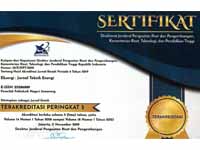Studi Eksperimental EGT Dan Smoke Opacity Pada Mesin Diesel Menggunakan Bahan Bakar Campuran Jatropha Dengan Sistem Cold EGR
DOI:
https://doi.org/10.32497/eksergi.v13i2.906Abstract
Penipisan bahan bakar solar yang berasal dari fosil, mendorong manusia untuk mencari bahan bakar alternatif yang dapat diperbaharui. Salah satu bahan bakar alternatif yang dapat menggantikan bahan bakar fosil dan dapat diperbaharui adalah jatropha biodiesel. Penggunaan bahan bakar jatropha tidak menjatuhkan performa dari mesin diesel akan tetapi nilai emisi NOx jatropha lebih tinggi dibandingkan dengan bahan bakar solar. Tehnik EGR membantu mereduksi emisi NOx tersebut, akan tetapi masih diperlukan pengkajian dampak EGR terhadap smoke opacity mesin diesel dengan memakai bahan bakar jatropha biodiesel. Pengujian dilakukan pada putaran mesin konstan 2000 rpm, dengan memvariasi bukaan katup EGR dari 0% - 100% dengan inteval 25% pada setiap pembebanan. Pengujian dilakukan dengan bahan bakar D100 dan D30J70. Hasil penelitian menunjukkan bahwa EGT menurun ketika menggunakan cold EGR maupun bahan bakar jatropha. Smoke opacity meningkat ketika dioperasikan dengan sistem EGR. Peningkatan smoke opacity juga terjadi ketika menggunakan bahan bakar jatropha dibandingkan dengan bahan bakar solar (D100).
Kata kunci: diesel, EGT, smoke opacity, cold EGR, jatropha
References
Agarwal, D., Singh, S.K, Agarwal, A.K. (2011), ”Effect of Exaust Gas Recirculation (EGR) on performance, deposits and durability of constant speed compression ignition engine”., Elsevier, 88, 2900-2907.
Avinash Kumar Agrawal. dkk. (2004), “Effect of EGR on the exhaust gas temperatur and exhaust”., Sadhana, 29, 275”“284.
Gomaa, M., Alimin, A.J., Kamarudin, K.A. (2011), “The effect of EGR rates on NOX and smoke emissions of an IDI diesel engine fuelled with Jatropha biodiesel blends”., International Energy and Environment Foundation, 2, 477 ”“ 49.
Gomma, M., Alimin, A.J., Kamarudin,
K.A. (2010), “Trade off Between NOx, Soot and EGR rates for IDI Diesel Engine Fuelled with JB5”., World Academy of Science, Engineering and Technology, 38, 522-527.
Heywood, John B.L. (1988), Internal Combustion Engine Fundamentals, McGraw-Hill, Inc., New York.
Pooja Ghodasara, Mayur Ghodasara. (2012), “Experimental studies in emission and performance characteritics in diesel engine using bio-diesel blend and EGR (exhaust gas recirculation)”., Emerging Technology and Advanced Engineering, 2, 2250-2459
Pradeep, V., Sharma, R.P. (2007), “Use of hot EGR for NOx cnontrol in a compression ignition engine fuelled with biodiesel from jatropha oil”., Renewable Energy, 32, 1132-1154.
Rajan, K. dan Senthil Kumar, K.R. (2009), “The effect of exhaust gas recirculation (EGR) on the performance and emission characteristics of diesel engine with sunflower oil methyl ester”., International Journal of Chemical Engineering Research, 1, 31 ”“ 39.
Rajan, K., Senthil Kumar, K.R. (2009), “The effect of exhaust gas recirculation (EGR) on the performance and emission characteristics of diesel engine with sunflower oil methyl ester”., International Journal of Chemical Engineering Research, 1, 31-39.
Saleh, H. E. (2009), “Effect of exhaust gas recirculation on diesel engine nitrogen oxide reduction operating with jojoba methyl ester”., Renewable Energy, 34, 2178-2186.
Senthil Kumar, M., Ramesh, A., Nagalingam, B. (2003), ”An experimental comparison of methods to use methanol and Jatropha oil in a compression ignition engine”., Biomass and Bioenergy, 23, 309-318
Downloads
Published
Issue
Section
License
Authors who publish with this journal agree to the following terms:Authors retain copyright and grant the journal right of first publication with the work simultaneously licensed under a Creative Commons Attribution License that allows others to share the work with an acknowledgement of the work's authorship and initial publication in this journal.
Authors are able to enter into separate, additional contractual arrangements for the non-exclusive distribution of the journal's published version of the work (e.g., post it to an institutional repository or publish it in a book), with an acknowledgement of its initial publication in this journal.
Authors are permitted and encouraged to post their work online (e.g., in institutional repositories or on their website) prior to and during the submission process, as it can lead to productive exchanges, as well as earlier and greater citation of published work (See The Effect of Open Access).






